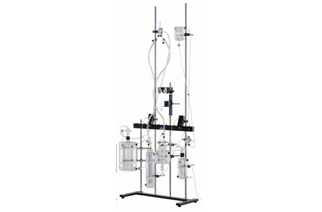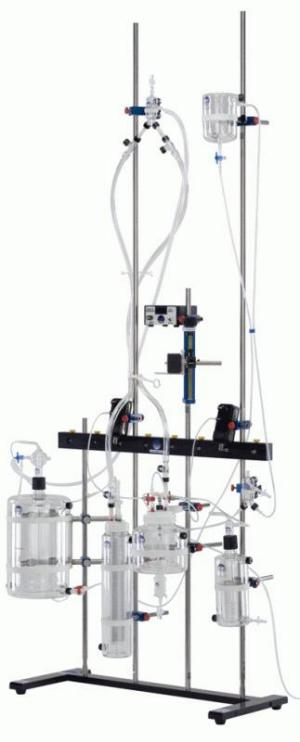

品牌:美国 Radnoti
离体肺灌流系统 (Radnoti Isolated Lung System #190101)
Radnoti 离体肺系统可以进行许多形式实验的探索。 (循环或非循环模式下的恒压或横流 灌注)
离体肺系统可以在以下两种情况应用:
Radnoti 改良的在体心/肺灌流 (in Vivo)
心肺标本不从动物体内取出,心肺仍然在动物的开放胸腔内。肺通过呼吸机保持血液或 灌注液的氧饱和。心肺通过肝素化的全血或灌注液灌流。温度由水套容器控温。容器可以调 节高度来实现右心房不同的前负荷压力 (preload) 。后负荷也可以通过调节回流顺应腔的 高度来实现。
离体肺灌流 (in Vitro)
肺不仅是对呼吸重要,同时它也是药物的靶点,包括挥发性的麻醉气体,生化或生物试 剂,涉及药物代谢与分布等。同时还涉及许多病理情况,包括缺血,水肿,和损伤疾病。离 体肺系统与离体心灌流系统有相似也有区别。两个系统都需要保持动物的生理温度,同时也 都需要通过 Kreb’s 或 Tyrode’s 液进行灌注。与离体心脏灌流一样,肺的脉管也是可以按 照恒压或者恒流的模式进行灌流。同时通过一个人造气管插入肺。肺的呼吸性能,可以通过 在特定呼吸频率下的呼出容量测定。不像心脏可以自发的搏动,肺的活动必须通过呼吸机辅 助进行。促使肺活动有两种方法。正压法和负压法。
注:本产品是主要用于基础医学研究的动物实验仪器。非临床医疗设备。
系统构成:
• 高科技肺腔
• 稳固可调节的4杆支架
• 膜氧合器
• 2个水套容器
• 减少大气泡对内皮因子损伤的气泡消除器
• 水,气体,灌注液控制集流腔
• 测量灌注压的内嵌压力感应器
• 用于确定吸气压力或呼气压力的压力感应器。
• 呼吸机施加不同速度或容量的湿润气体或其它气体进入肺。
• 用于控温的再循环,恒温浴槽
• 蠕动泵
• 肺插管连接一个力传感器用于测量肺水肿
可选组件
• 测量灌注流量的内嵌流量仪
• 测量 PH,氧,二氧化碳的内嵌式离子选择电极
• 用于小鼠到兔或者更大动物的人造气管插管
• 呼出气体或者灌注液可以被采集进行代谢研究 (代谢设备,及数据采集分析系统)
The Radnoti Isolated Lung System permits a wide variety of experimental formats to be explored.
Constant pressure and constant flow perfusion can occur in both re-circulating and
non-re-circulating modes.
Components Included With the System:
High-tech lung chamber
Sturdy, adjustable four bar stand.
Membrane oxygenator for solutions containing proteins or blood
Two water-jacketed reservoirs
Bubble traps to reduce endothelial damage caused by large gas bubbles
Manifolds for water, gas and perfusate control.
Inline pressure transducers to measure perfusion pressure
Pressure sensors are used to determine inspiration and expiration pressures and the gasses passed into the lung are humidified using a gas chamber.
A variable speed and volume respirator delivers humidified air or other gasses to the lungs (positive pressure) or creates a cycling negative/positive pressure change in the lung chamber (negative pressure).
Re-circulating, constant temperature bath for temperature control.
Peristaltic pump for recirculating of solutions and to maintain a constant pressure head or flow.
The lung cannula is attached to a force transducer with a +/- 5 volt readout for experimenters interested in measuring lung edema.
Optional Components:
Inline flow meters measure perfusion flow
Inline ion selective electrodes to measure perfusate pH, oxygen and carbon dioxide.
By changing artificial tracheas and the lung chamber in concert with respirator settings and control valves, lungs from subjects from mice to rabbits or larger can be used.
Expired air or perfusate can also be collected for metabolic studies. that can be linked to a data acquisition system.
Radnoti Modification for Heart/Lung Perfusion (HLP) in Vivo
The advantage of the Heart Lung preparation is that the left and right heart regions of the heart can be investigated independently in a single system configuration. The heart-lung preparation does not consist of an isolated organ removed from the body, since heart and lung remain in the open thorax of the donor animal. The lung is ventilated using a small animal respirator that maintains oxygenation of the blood or perfusion buffer. Heart and lung are supplied with heperinised whole blood or a buffer solution from a Water-Jacketed temperature controlled reservoir. The reservoir is adjustable in height in order to vary the pressure in the right atrium (preload). After load resistance can be adjusted by variation in the elevation of the outflow compliance chamber. The Radnoti system is easily instrumented for a wide range of experimental parameters. The Heart Lung preparation is adapted from the Radnoti 190101 Isolated lung system by removal of the membrane oxygenator and the Isolated lung chamber. In place of the isolated lung chamber, a rodent surgical table is used (sold separately).
Overview of Isolated Lung Perfusion.
The lungs are important not only for respiration, but also as a target organ for drugs that include volatile anesthetics, biochemical and biological agents, are involved in drug metabolism and distribution and are involved in a number of pathological scenarios, including ischemia, edema, various diseases and trauma. The isolated lung system has both similarities and differences to the isolated heart system. Both systems require maintenance of the organ at physiological temperatures and perfusion with crystalloid solutions, such as Kreb’s or Tyrode’s solutions, or admixtures containing blood. Like the isolated heart system, the vasculature of the lung can be perfused in a constant pressure or a constant pressure mode and the lung is cannulated on an artificial trachea, just as the heart is cannulated on an artificial aorta. This perfusion, can be in either retrograde, as in the Langendorff, or anterograde to normal blood flow. The respiratory
performance of the lung can be measured in terms of respiratory volumes exchanged at a given rate, while cardiac mechanical performance is measured by its developed pressure or stroke volume multiplied by its rate in beats per minute. Unlike the heart, the isolated lung does not have an intrinsic pacemaker, so its mechanical activity must be generated through one of two ways. In the positive pressure method, air is forced into the artificial trachea and then into the lung via a respirator. In the negative pressure method, the lungs are placed in a sealed chamber that mimics the situation in the subject’s chest cavity. In vivo, it is the action of the diaphragm muscle that creates a reduction of internal pressure, while in vitro a vacuum is generated by a respirator in the sealed chamber that permits air to follow its pressure gradient into the lung. To remove the air, the respirator then pushes air into the chamber, deflating the lungs.